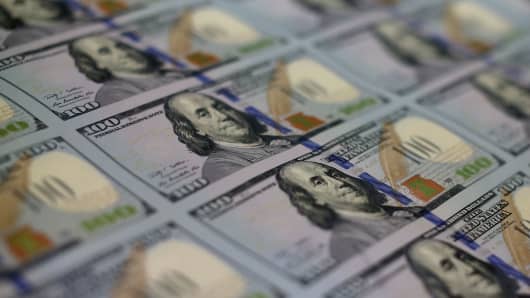As the U.S. dollar looks set to continue its reign over
global currency markets, some of Asia's emerging market currencies are
more at risk than others, analysts say.
"Fear of the Federal Reserve is too big a risk in the near term. Strong employment data or indications from the Fed that rate hikes are imminent might push Asian currencies lower," according to a Societe Generale note published on Thursday.
Dollar bulls have been on a run since last summer, pushing the dollar index to 11-year highs. Despite some weak U.S. economic data including the latest consumer spending and factory activity, the Fed is widely forecast to raise interest rates sometime between June and October.
In Asia, some currencies are more vulnerable than
others, analysts warned. Indonesia's rupiah tops the danger list, but investors also need to watch the Taiwan dollar.
Rupiah at risk
Euphoria around the election of President Joko Widodo last July sparked a rush into Indonesian assets, but that momentum appears to be reversing after the central bank surprised markets with a 25-basis-point rate cut to 7.5 percent mid-February – its first cut since 2011.
The central bank conceded that lower oil prices would damp inflation, raising concerns that more rate cuts could follow.
"Fear of the Federal Reserve is too big a risk in the near term. Strong employment data or indications from the Fed that rate hikes are imminent might push Asian currencies lower," according to a Societe Generale note published on Thursday.
Dollar bulls have been on a run since last summer, pushing the dollar index to 11-year highs. Despite some weak U.S. economic data including the latest consumer spending and factory activity, the Fed is widely forecast to raise interest rates sometime between June and October.
In Asia, some currencies are more vulnerable than
others, analysts warned. Indonesia's rupiah tops the danger list, but investors also need to watch the Taiwan dollar.
Rupiah at risk
Euphoria around the election of President Joko Widodo last July sparked a rush into Indonesian assets, but that momentum appears to be reversing after the central bank surprised markets with a 25-basis-point rate cut to 7.5 percent mid-February – its first cut since 2011.
The central bank conceded that lower oil prices would damp inflation, raising concerns that more rate cuts could follow.
The Indonesia rupiah has dropped around 1.8 percent since the central bank's surprise move.
"Bank Indonesia's recent surprise monetary policy easing, and its comfort with the continued weakness of its currency… is unlikely to be supportive," Barclays said in a research note on Thursday. The Indonesia rupiah has dropped around 1.8 percent since the central bank's surprise move.
"Bank Indonesia's recent surprise monetary policy easing, and its comfort with the continued weakness of its currency… is unlikely to be supportive," Barclays said in a research note on Thursday.
These EM bonds are vulnerable to king dollar's reign
"Within Asia, Indonesia is most susceptible to capital flight because it has been in the midst of a capital inflow surge," said Societe General emerging markets strategist Jason Daw.
Concerns over Indonesia's current account deficit are another risk factor. A wide current account deficit saw the rupiah tumble in 2013 when the Fed first broached the idea tapering its quantitative easing program. While the current account deficit has narrowed modestly, if data released later this year show signs of deterioration and coincide with a Fed rate hike, the rupiah could take another hit.
"[A] potential June Fed lift-off is another headwind for the Indonesian rupiah," according to the Barclays note.
Other dollar risks
Low yields could put other Asian currencies at risk going forward, the Taiwan dollar in particular, analysts warn.
"[The Taiwan dollar] remains vulnerable to net capital outflows from local residents and an unattractive yield," Societe Generale said.
Taiwan's benchmark 10-year bond is currently yielding 1.628 percent, compared with 2.115 percent for U.S. Treasury's.
The Taiwan dollar weakened nearly 6 percent against the U.S. dollar last year, but is up around 0.7 percent so far this year.
"Bank Indonesia's recent surprise monetary policy easing, and its comfort with the continued weakness of its currency… is unlikely to be supportive," Barclays said in a research note on Thursday. The Indonesia rupiah has dropped around 1.8 percent since the central bank's surprise move.
"Bank Indonesia's recent surprise monetary policy easing, and its comfort with the continued weakness of its currency… is unlikely to be supportive," Barclays said in a research note on Thursday.
These EM bonds are vulnerable to king dollar's reign
"Within Asia, Indonesia is most susceptible to capital flight because it has been in the midst of a capital inflow surge," said Societe General emerging markets strategist Jason Daw.
Concerns over Indonesia's current account deficit are another risk factor. A wide current account deficit saw the rupiah tumble in 2013 when the Fed first broached the idea tapering its quantitative easing program. While the current account deficit has narrowed modestly, if data released later this year show signs of deterioration and coincide with a Fed rate hike, the rupiah could take another hit.
"[A] potential June Fed lift-off is another headwind for the Indonesian rupiah," according to the Barclays note.
Other dollar risks
Low yields could put other Asian currencies at risk going forward, the Taiwan dollar in particular, analysts warn.
"[The Taiwan dollar] remains vulnerable to net capital outflows from local residents and an unattractive yield," Societe Generale said.
Taiwan's benchmark 10-year bond is currently yielding 1.628 percent, compared with 2.115 percent for U.S. Treasury's.
The Taiwan dollar weakened nearly 6 percent against the U.S. dollar last year, but is up around 0.7 percent so far this year.


No comments:
Post a Comment